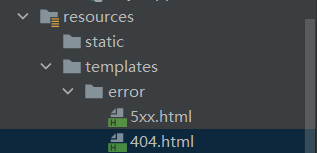SpringBoot error handling
By default, Spring Boot provides a / error mapping to handle all errors, and will be registered as a global error page in the servlet container
json will be generated on the machine client
The browser client will generate the whitelabel view
They all contain error messages
use
Error handling is so well packaged in springBoot that we can directly write 404500 html to automatically jump when there is an error in the browser
So you just

That's it
Web native component injection (distributed)
catalogue

Servlet
It is a server-side program written in Java for small service program or service connector, which is independent of platform and protocol
The main function is to interactively browse and generate data and generate dynamic Web content
MyServlet
package com.example.day3.servlet;
import javax.servlet.ServletException;
import javax.servlet.annotation.WebServlet;
import javax.servlet.http.HttpServlet;
import javax.servlet.http.HttpServletRequest;
import javax.servlet.http.HttpServletResponse;
import java.io.IOException;
@WebServlet("/my")
public class MyServlet extends HttpServlet {
@Override
protected void doGet(HttpServletRequest req, HttpServletResponse resp) throws ServletException, IOException {
resp.getWriter().write("this is my servlet");
}
}
Note the @ WebServlet annotation
@WebServlet("/my")
This annotation is used to tell SpringBoot that it is a servlet written by itself and needs to access the path in ()
Day3Application
package com.example.day3;
import org.springframework.boot.SpringApplication;
import org.springframework.boot.autoconfigure.SpringBootApplication;
import org.springframework.boot.web.servlet.ServletComponentScan;
@ServletComponentScan(basePackages = "com.example.day3")
@SpringBootApplication
public class Day3Application {
public static void main(String[] args) {
SpringApplication.run(Day3Application.class, args);
}
}
Note the @ ServletComponentScan annotation
@ServletComponentScan(basePackages = "com.example.day3")
This annotation must be written. This annotation is used to scan the servlet under our project package. It cannot work without writing
Result display

Filter
Filter, also known as filter, is the most practical technology in Servlet Technology. Filter can intercept all web resources managed by web server, such as Jsp, Servlet, static picture file or static html file, so as to realize some special functions. For example, it implements some advanced functions such as URL level permission access control, filtering sensitive words, compressing response information and so on.
It is mainly used to preprocess user requests or post process HttpServletResponse.
MyFilter
package com.example.day3.servlet;
import lombok.extern.slf4j.Slf4j;
import javax.servlet.*;
import javax.servlet.annotation.WebFilter;
import java.io.IOException;
//Set to intercept all resources under the imgs package
@WebFilter(urlPatterns = {"/imgs/*"})
@Slf4j
public class MyFilter implements Filter {
@Override
public void init(FilterConfig filterConfig) throws ServletException {
log.info("MyFilter Initialization complete");
}
@Override
public void doFilter(ServletRequest servletRequest, ServletResponse servletResponse, FilterChain filterChain) throws IOException, ServletException {
log.info("MyFilter implement");
filterChain.doFilter(servletRequest,servletResponse);
}
@Override
public void destroy() {
log.info("MyFilter Destroy");
}
}
Note the @ WebFilter annotation
//Set to intercept all resources under the imgs package
@WebFilter(urlPatterns = {"/imgs/*"})
Listener
Listen for specific events in the web, such as the creation and destruction of ServletContext, httpsession and ServletRequest; Creation, destruction and modification of variables
MyListener
package com.example.day3.servlet;
import lombok.extern.slf4j.Slf4j;
import javax.servlet.ServletContextEvent;
import javax.servlet.ServletContextListener;
import javax.servlet.annotation.WebListener;
@WebListener
@Slf4j
public class MyListener implements ServletContextListener {
@Override
public void contextInitialized(ServletContextEvent sce) {
log.info("MyListener Listening item initialization");
}
@Override
public void contextDestroyed(ServletContextEvent sce) {
log.info("MyListener Monitor item destruction");
}
}
Note the @ WebListener annotation
@WebListener
Use display


Web native component injection (monolithic) uses RegistrationBean
servlet, filter and listener are written in the way of using RegistrationBean as a whole
We still need to write separate servlet, filter and listener classes ourselves
Compared with distributed, the difference is that there is no need to write @ webservlet, @ webfilter and @ weblistener annotations. Instead, they are created in the way of methods in the user-defined RegistrationBean configuration class
catalogue

MyServlet
package com.example.day3.servlet;
import javax.servlet.ServletException;
import javax.servlet.annotation.WebServlet;
import javax.servlet.http.HttpServlet;
import javax.servlet.http.HttpServletRequest;
import javax.servlet.http.HttpServletResponse;
import java.io.IOException;
public class MyServlet extends HttpServlet {
@Override
protected void doGet(HttpServletRequest req, HttpServletResponse resp) throws ServletException, IOException {
resp.getWriter().write("this is my servlet");
}
}
MyFilter
package com.example.day3.servlet;
import lombok.extern.slf4j.Slf4j;
import javax.servlet.*;
import javax.servlet.annotation.WebFilter;
import java.io.IOException;
@Slf4j
public class MyFilter implements Filter {
@Override
public void init(FilterConfig filterConfig) throws ServletException {
log.info("MyFilter Initialization complete");
}
@Override
public void doFilter(ServletRequest servletRequest, ServletResponse servletResponse, FilterChain filterChain) throws IOException, ServletException {
log.info("MyFilter implement");
filterChain.doFilter(servletRequest,servletResponse);
}
@Override
public void destroy() {
log.info("MyFilter Destroy");
}
}
MyListener
package com.example.day3.servlet;
import lombok.extern.slf4j.Slf4j;
import javax.servlet.ServletContextEvent;
import javax.servlet.ServletContextListener;
import javax.servlet.annotation.WebListener;
@Slf4j
public class MyListener implements ServletContextListener {
@Override
public void contextInitialized(ServletContextEvent sce) {
log.info("MyListener Listening item initialization");
}
@Override
public void contextDestroyed(ServletContextEvent sce) {
log.info("MyListener Monitor item destruction");
}
}
(*)MyRegistrationConfig
Note that @ Bean is used for registration on each method
package com.example.day3.servlet;
import org.springframework.boot.web.servlet.FilterRegistrationBean;
import org.springframework.boot.web.servlet.ServletListenerRegistrationBean;
import org.springframework.boot.web.servlet.ServletRegistrationBean;
import org.springframework.context.annotation.Bean;
import org.springframework.context.annotation.Configuration;
import java.util.Arrays;
@Configuration
public class MyRegistrationConfig {
@Bean
public ServletRegistrationBean myServlet() {
MyServlet myServlet = new MyServlet();
return new ServletRegistrationBean(myServlet, "/my");
}
@Bean
public FilterRegistrationBean myFilter() {
MyFilter myFilter = new MyFilter();
FilterRegistrationBean filterRegistrationBean = new FilterRegistrationBean(myFilter);
//Set interception path
filterRegistrationBean.setUrlPatterns(Arrays.asList("/my", "/img/*"));
return filterRegistrationBean;
}
@Bean
public ServletListenerRegistrationBean myListener(){
MyListener myListener = new MyListener();
return new ServletListenerRegistrationBean(myListener);
}
}